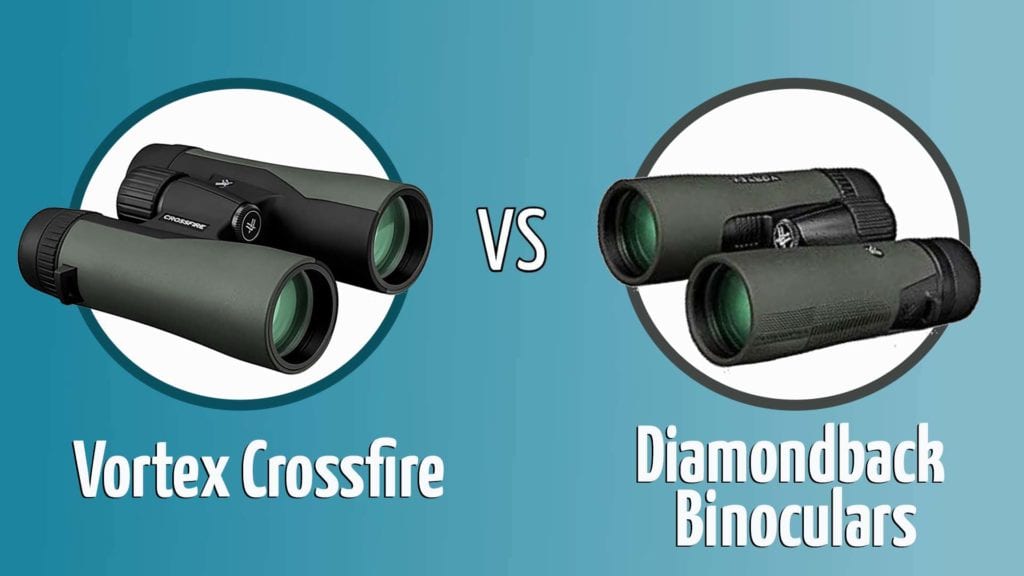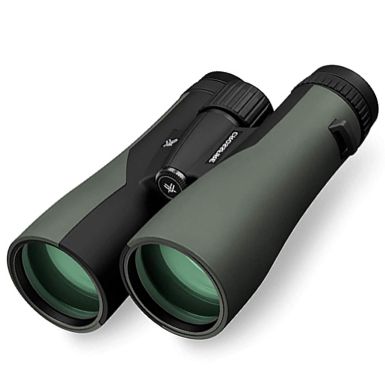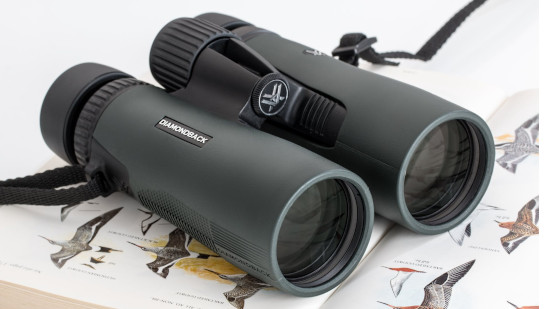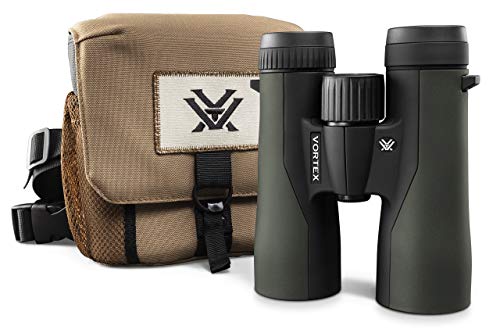Vortex Crossfire vs Diamondback Binoculars: Which is Best?
Last Updated on


A Quick Comparison
| Image | Product | Details | ||
|---|---|---|---|---|
| Top Pick |
 |
Vortex Optics Diamondback Roof Prism |
|
CHECK PRICE |
| Best Value |
 |
Vortex Optics Crossfire Roof Prism |
|
CHECK PRICE |
Comparison Summary
Vortex is known for making some of the best binoculars around. Two of their most popular binoculars, the Crossfire and Diamondback, look very similar, though they stand at different price points. Is the Diamondback worth the extra price, or could you be just as satisfied saving your money on the Crossfire?
Quick Rundown of the Vortex Crossfire
The Crossfire is slightly heavier and bulkier than the Diamondback. The price point on the Crossfire series is a clear winner, with a savings of $50 to $100 on the comparable Diamondback models. For most users, the savings will be worth more than the minimal performance gains you’d see by upgrading to the Diamondback.
- Costs much less than the Diamondback
- Rugged rubber armor protects against drops
- Nitrogen purging provides good weather resistance
- Has a longer close focus distance
- Smaller field of view
Overall, the more expensive Diamondbacks are a higher quality set. They’ve got some features that make them more rugged and durable, so they’ll hold up better in extreme conditions. Moreover, they’ve got the larger field of view, they’re smaller, and lighter as well.
But that doesn’t mean that you should discount the Crossfire. Though the Diamondbacks have slightly better specs, the differences aren’t staggering by any means. But the price difference is. For most enthusiasts, the specs and performance provided by the Crossfire are more than adequate, with a cost savings that make them a very appealing option.
Quick Rundown of the Vortex Diamondback
There’s no question, the Diamondback does outperform the Crossfire. The more advanced optical system in the Diamondback series means a better field of view and brighter images. For a seasoned bino-user, the difference in performance might warrant the higher price tag. But the difference is minimal, so for the average user, the cost difference will be too great.
- Argon purging provides superior weather resistance
- Shorter close focus distance
- Larger field of view
- Far more expensive than the Crossfire

What are the differences between them?
At first glance, you might not pick out any differences between these two binoculars. They look very similar, and even on the spec sheet, they’re not too far apart. But there are differences between them, and some of those differences might make one more preferable to you than the other.
Performance
Edge: Diamondback
At the end of the day, performance is the most important aspect of any pair of binoculars. Regardless of how light, durable, or attractive they are, if they don’t allow you to clearly see distant subjects, then they’re not much good.
Both of these binoculars are solid performers, but the Diamondback has a leg up on the Crossfire. Let’s start with the close focus distance.
- Close Focus
The Diamondback binoculars have a close focus of five feet, while the Crossfire has a slightly longer close focus of six feet. A few years ago, you’d be hard pressed to find binoculars that could focus within ten feet, so both of these models are doing good. Still, if you need to focus on something close by, such as a butterfly, the Diamondback wins.
- Field of View
The field of view measures how wide of an area you can view at a certain distance, usually measured to 1,000 yards. In this case, the Diamondback has a 330-foot field of view, while the Crossfire has a field of view that spans 325 feet. This isn’t a major difference by any means, but the Diamondback still takes the win, albeit, slightly.

Durability
Edge: Diamondback
Which binoculars will hold up better? Both are built tough enough to withstand impacts and recoil, so it’s a hard call. In the end, the Diamondback will win due to the Argon purging. But, what is Argon purging?
Argon vs Nitrogen Purging
To make binoculars resistant to water and weather, the lenses and seals are purged with gas. Often, nitrogen is used, like in the Crossfire. This is a perfectly adequate method of purging and weatherproofing, but it’s not optimal.Argon purging is much more expensive, hence, the higher price on the Diamondback binoculars. But it’s also more resilient because argon molecules are larger than nitrogen molecules. This makes it easier for nitrogen molecules to leak out after an impact, thereby reducing the level of weather-resistance provided by the purging.
Design
Slight Edge: Diamondback
Though both of these binoculars look very similar, there are some design differences to account for. For instance, both are covered in a rugged rubber armor that protects against drops and impacts. But the Diamondback has more grip to help prevent a spill in the first place.
The Diamondback model is also a bit smaller and lighter than the Crossfire, making it easier to carry and store. But the difference is minimal. The Diamondback is 1.7 ounces lighter than the Crossfire, which might not even be enough to notice. But it’s also just a hair smaller each way, making it the more compact option overall.

Price
Edge: Crossfire
The Diamondback offers more lens strength varieties than does the Crossfire, but in comparing them to their equivalent varieties, the Diamondback is more expensive across the board. Expect to pay roughly $50 to $100 more for a Diamondback over an equivalent Crossfire. Because the Diamondback has more varieties, though, you’ve got more of a price spread, with the 8×28 model being least expensive.

What the Users Say
Now you’ve heard our opinions on these two binoculars, but we’re not the only ones who have put them to the test. To ensure you get a more well-rounded view of these products, we scoured the internet, searching through reviews, forums, and more to get the opinions of other people who have been using these binoculars out in the field.
Build Quality
Most users seemed impressed with the overall build quality of both pairs. Many reported dropping their binoculars with little consequence. We don’t recommend testing it out, but they’ve been shown to withstand drops from varying heights.
Viewing Experience
When it comes to the overall viewing experience, many users reported no difference between the models. But this is likely due to their untrained eyes. Some of the most experienced users were able to pick out the difference visually. These users noticed slightly clearer images with less chromatic aberration from the Diamondback.
Low-Light Performance
One trait that was mentioned several times regarded low-light performance. Many users were impressed with the Diamondback’s ability to magnify any light source, no matter how minimal, making it possible to see in very low-light conditions. The Crossfire still offered respectable low-light performance, but couldn’t match the Diamondback.
Size and Portability
Many users seemed to prefer the more compact size of the Diamondback, particularly if they’re using the binoculars in remote locations that require wearing them around the neck for long periods. The extra size and weight of the Crossfire start to add up after many miles. Wisely, Vortex has a branded shoulder harness designed to accommodate its binoculars.
- Housing your binoculars and protecting them from the elements while keeping them close at hand is...
- It accommodates a range of full size binoculars, yet keeps them snug and secure. The mesh side...
Price
The number one thing reported by users of both binoculars was that the price difference didn’t equal out to the difference in performance. These users seemed to think that the Crossfire offers better bang for your buck, even if the Diamondback provides sightly better performance.

Conclusion
In the end, you really can’t go wrong with either of these binoculars. They’re both high-quality sets of moderately priced binos that will provide you with many years of great performance. Still, you have to choose one, so let’s break it down, which is best?
The Crossfire is the better choice for most enthusiasts. The lower price is more comfortable for most wallets, especially when you consider the minimal performance gains on the higher-priced Diamondback. With the Crossfire, you’ll get rugged armor and protection, adequate weatherproofing, and very solid optics.
But there’s no doubt that if performance is more important than price to you, you’ll want the Diamondback. This pair is smaller, lighter, and has a slightly better viewing experience. It’ll provide better low-light performance and superior weather-resistance thanks to the argon purging. If you count on your binos daily, then the Diamondback is worth the higher price.
New posts from the blog:
Header image credit: CC0 Public Domain, Pxhere
About the Author Robert Sparks
Robert’s obsession with all things optical started early in life, when his optician father would bring home prototypes for Robert to play with. Nowadays, Robert is dedicated to helping others find the right optics for their needs. His hobbies include astronomy, astrophysics, and model building. Originally from Newark, NJ, he resides in Santa Fe, New Mexico, where the nighttime skies are filled with glittering stars.
Related Articles:
Holy Stone Drone Review of 2024 – Pros, Cons, and Verdict
Ultraviolet Light vs Black Light: What’s the Difference?
Light Waves vs. Sound Waves: The Key Differences
Infrared vs. Thermal Cameras: How Are They Different?
Far Infrared vs Near Infrared: What’s The Difference?
Mottled Duck vs. Mallard vs. Black Duck: What’s the Difference?
Shutter Speed vs Frame Rate: Pros, Cons, & Difference
Oriole vs Goldfinch: How to Tell the Difference




